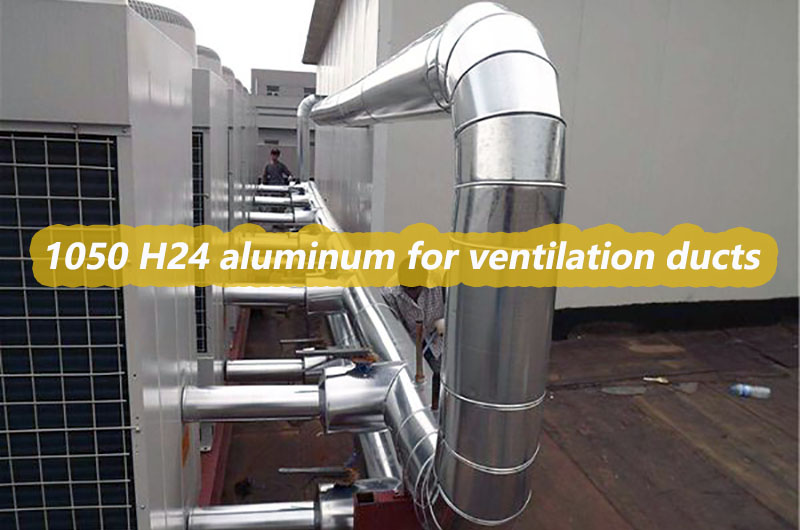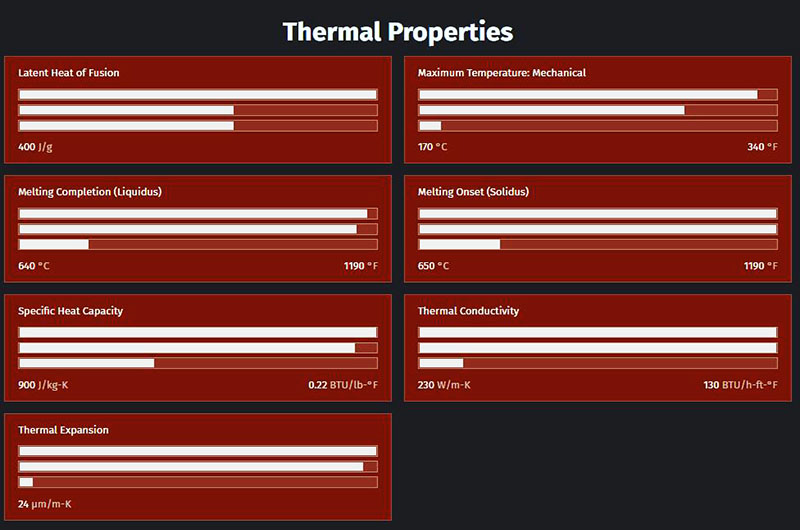- "1050" refers to aluminum alloy, a commercially pure aluminum with excellent corrosion resistance and workability.
- "H24" refers to the tempered state of aluminum. In this case, it is shown that the aluminum has been strain hardened and partially annealed, providing moderate strength and good formability.
Because it is corrosion-resistant, lightweight and easy to manufacture, 1050 H24 aluminum sheet plate is commonly used in ventilation ducts. It can withstand conditions within ducts and is often chosen for its durability and compatibility with HVAC systems.
Ventilation ducts are widely used and can be seen in almost all places. Whether in offices or public buildings, ventilation duct systems will be installed. Aluminum alloy plates are usually used in the market to manufacture ventilation ducts, among which 1050 h24 aluminum alloy plate is a commonly used material because of its good use effect.

Why do ventilation ducts use 1050 H24 alloy aluminum plates?
- 1. Good processability: 1050 alloy aluminum plates are easy to process into various shapes and are suitable for manufacturing various components and connectors required for ventilation ducts. This makes the manufacturing process more efficient and able to cater for pipes of different shapes and sizes.
- 2. Corrosion resistance: Ventilation ducts need to be used in various environmental conditions, including moisture, high temperature, etc. 1050 alloy aluminum plate has high corrosion resistance and can resist oxidation, corrosion and chemical corrosion, extending the service life of ventilation ducts.
- 3. Lightweight characteristics: Compared with other materials, aluminum has a lighter density, so the ventilation ducts made are lighter. This not only reduces the burden of handling and installation, but also helps reduce the load on the overall building structure.
- 4. Formability: 1050 H24 aluminum has good formability, allowing it to be easily formed and manufactured into pipes of various sizes and configurations. This design flexibility helps meet specific ventilation requirements in different environments.
- 5. Thermal conductivity: Although not as high as some other aluminum alloys, 1050 H24 aluminum still has considerable thermal conductivity. This feature ensures efficient heat transfer within the ductwork, helping to improve the overall energy efficiency of the heating, ventilation and air conditioning (HVAC) system.
- 6. Durability: The durability of aluminum ensures the longevity of your ventilation ducts, reducing the need for frequent maintenance or replacement. This durability is especially valuable in industrial or commercial settings where duct systems may be subject to heavy use or harsh conditions.
- 7. Fire resistance: Aluminum has inherent fire resistance properties, making it a suitable material for ventilation ducts in buildings where fire safety is important. In addition, aluminum pipes can be coated with flame-retardant materials for added protection.
- 8. Cost-Effectiveness: 1050 H24 aluminum is relatively inexpensive compared to other materials commonly used in ductwork, such as stainless steel or galvanized steel. This makes it a cost-effective choice for ventilation systems, especially in projects with a limited budget.
1050 H24 alloy aluminum plate has good processability, corrosion resistance and lightweight properties. Using 1050 H24 aluminum plate to make ventilation ducts can achieve a balance of performance, durability and cost-effectiveness, making it an ideal choice for a variety of residential, commercial and industrial applications. Suitable choice.
Details of 1050 H24 alloy aluminum plate for ventilation ducts
- Thickness: 0.1-500mm
- Width: 20-2650mm
- Length: 500-16000mm
- Material status: F, O, H12, H14, H16, H18, H19, H22, H24, H26, H28, H111, H112, H114
- Typical products: PS board base, signs, heat sinks, stamping parts, lamps, battery soft connections, etc.
Ventilation duct aluminum plate requirements
Aluminum panels used for ventilation ducts, especially those made from 1050 H24 aluminum alloy, need to meet specific requirements to ensure the durability, safety and efficiency of the ventilation system.
- 1. Thickness: The thickness of the aluminum plate should be suitable for the intended use and should meet the structural requirements of the ventilation duct. Typical thicknesses for this type of application range from 1.5 mm to 3 mm, depending on factors such as pipe size and pressure requirements.
- 2. Surface finish: The surface of the aluminum plate should be smooth and free of scratches, dents, uneven unevenness and defects. The smooth surface minimizes air resistance and allows efficient airflow within the duct.
- 3. Flatness: The surface of the aluminum plate should have uniform flatness to ensure the correct sealing and installation of the ventilation duct. Any warping or twisting can cause air leaks and reduce system efficiency.
- 4. Corrosion resistance: Aluminum naturally forms an oxidation protective layer and is corrosion-resistant. However, in environments where corrosion is a problem (such as industrial or coastal areas), aluminum panels may require additional protective coatings or treatments to enhance their durability.
- 5. Fire resistance: Although aluminum itself is non-combustible, ventilation ducts may withstand high temperatures in the event of a fire. Aluminum panels should have sufficient heat resistance to maintain structural integrity and prevent the spread of fire within the duct system.
- 6. Comply with standards: Aluminum panels should comply with relevant industry standards and specifications, such as those set by ASTM International (formerly the American Society for Testing and Materials) or other national and international standards organizations.
- 7. Dimensional tolerances: The dimensions of aluminum plates should adhere to specified tolerances to ensure compatibility with other piping components and correct fit during installation.
By meeting these requirements, aluminum panels can effectively improve the performance and service life of ventilation duct systems, ensuring efficient airflow and maintaining indoor air quality.
1050 H24 aluminum sheet plate for ventilation ducts Mechanical Properties

1050 H24 aluminum sheet plate for ventilation ducts Thermal Properties

Precautions for 1050 H24 aluminum sheet plate for ventilation ducts
When handling 1050 H24 aluminum sheet for ventilation ducting, it is crucial to take certain precautions to ensure safety and maintain the quality of the material.
- 1. Handling: Handle aluminum panels carefully to prevent any scratches or dents that may compromise their integrity.
- 2. Storage: Store aluminum sheets in a dry, well-ventilated area to prevent moisture accumulation, which can lead to corrosion.
- 3. Transportation: During transportation, the plates should be fixed to prevent the plates from moving or colliding with each other and causing damage.
- 4. Cutting and processing: Use appropriate tools and equipment for cutting and processing of aluminum plates to avoid any deformation or burrs. Lubricants may be needed to reduce friction and heat generation during cutting.
- 5. Cleaning: Before manufacturing, clean the surface of the aluminum plate to remove dirt, oil or contaminants that may affect the adhesion of the coating or paint.
- 6. Welding: If welding is required, ensure proper ventilation to prevent inhalation of fumes. Follow recommended welding procedures and use compatible filler materials to maintain the integrity of the weld.
- 7. Surface protection: Consider applying a protective coating or film on the surface of the aluminum plate to prevent scratches and corrosion during manufacturing and installation.
- 8. Installation: Install ventilation ducts following manufacturer guidelines and industry standards to ensure proper performance and longevity. Use proper fasteners and techniques to secure ductwork in place.
- 9. Maintenance: Regularly inspect ventilation ducts for any signs of damage or corrosion, and address any issues promptly to prevent further deterioration.
- 10. Safety Equipment: When handling aluminum panels or performing manufacturing tasks, wear appropriate personal protective equipment (PPE), such as gloves, safety glasses, and respiratory protection, if necessary.

